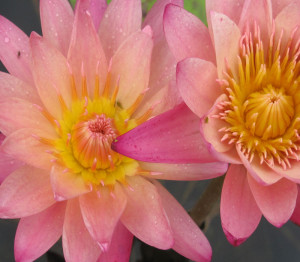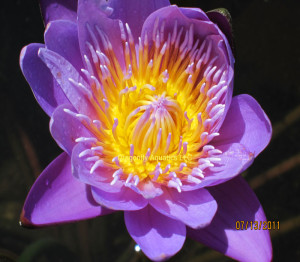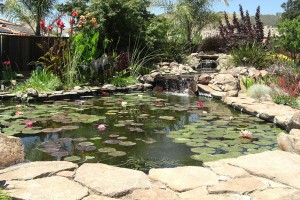 Its officially fall now and we need to begin preparing our pond for the winter and hopefully a cleaner pond for spring. I've listed a few maintenance tips to guide you through preparing your pond for the winter. I still have a few flowers appearing in my pond but I think they are almost through blooming for the season 🙁
Its officially fall now and we need to begin preparing our pond for the winter and hopefully a cleaner pond for spring. I've listed a few maintenance tips to guide you through preparing your pond for the winter. I still have a few flowers appearing in my pond but I think they are almost through blooming for the season 🙁
FALL/WINTER POND MAINTENANCE TIPS
1. Before winter arrives, you will want to make sure your pond and filtering system are clean to ensure good water quality throughout the winter months. With the arrival of fall it is wise to do a partial water change to remove any built up contaminants to improve water quality. Partial water changes need to be made before water temperatures fall below 60 degrees to minimize fish stress. Adding pond salt at this time will improve the slime coating of fish, to help them ward off disease and parasites.
2. Before the leaves begin to fall, cover your pond with one of ourpond nets. The goal is to try and keep the pond as clean as possible for the winter months. Leaves will sink to the bottom of the pond and rot, causing excess carbon dioxide and hydrogen sulfide. After the first frost, take out any floating plants, as these will begin to decay. Trim back hardy lilies and bog plants and place below the freeze line.
3. Switch to Microbe-Lift Autumn/Winter Prep. This will help break down organic material in the pond before winter sets in. Microbe-Lift Autumn/Winter Prep helps accelerate the decomposition of leaves, scum, sediment and other organic matter during the fall and throughout the winter months. Also, Microbe-Lift Autumn/Winter Prep helps to maintain a healthy immune system for your fish during the winter months. Microbe-Lift Autumn/Winter Prep will help jump-start your pond to a healthier environment in the spring.
4.Reduce your fish feeding as the water temperatures drop below 60 degrees. Start feeding your fish a couple of times a week. We recommend switching to a wheat germ based fish food formulated for fall and spring feeding. When water temperatures drop below 60 degrees, the metabolism of your fish slow down. Both Tetra-Pond Spring/Fall and Microbe-Lift Cold Weather fish food are highly digestible cool weather diets that are made with less protein, but contain wheat germ, which is easily digested. They also contain higher levels of fat, which help your fish survive their winter hibernation. When water temperatures reach 50 degrees, stop feeding your fish completely. Feeding at water temperatures below 50 degrees can possibly kill your fish. A pond thermometeris a must have. This will help you in determining when to stop feeding your fish and will also help to know when to begin feeding your fish in the spring. Its also a good idea to know your water temperature for those adding tropical pond plants to your pond in the spring.
5.Adding Microbe-Lift Barley Straw Extract will help control string algae throughout the fall and winter months. Barley Straw Extract is an effective and eco-friendly way to reduce algae. Unlike algaecides, which are ineffective in water temperatures below 50 degrees, Microbe-Lift Barley Straw Extract will continue to control algae throughout the winter months.
6.Before freezing temperatures begin, install a pond de-icer. Ponds covered with ice do not allow toxic gases to escape causing fish loss. A pond de-icer will keep a section of your pond open to allow oxygen and gas exchange.
7.During the winter removing snow from the surface of the pond will help submerged plants and microscopic aquatic plants to continue to produce oxygen as long as light penetrates through the ice. Insufficient light, along with the decomposition of plant and leaf debris may result in insufficient oxygen for the fish, causing them to suffocate. Removing the snow from a portion of your surface area will reduce the likelihood of this occurring.
Remember to add a tray of sand in your pond for the frogs to have a place to winter over.
 It won't be long and summer will be over. I already notice a difference with the days getting shorter. It has started to cool off some from the hot weather we've been having. All is doing well in the pond and it won't be long and the garden will be finished. I canned the first of the tomatoes last week ending up with about 27 quarts so far. I'm sure tomorrow I'll be able to add to that.
It won't be long and summer will be over. I already notice a difference with the days getting shorter. It has started to cool off some from the hot weather we've been having. All is doing well in the pond and it won't be long and the garden will be finished. I canned the first of the tomatoes last week ending up with about 27 quarts so far. I'm sure tomorrow I'll be able to add to that.
Finding more time now to do other things since the pond season is starting to slow down. There is little time during March, April, May and June, but then July things start to slow some. I notice the waterlilies seem to have to slowed down but when they do bloom are still wonderful.
Enjoy why we can......the tropicals are the first to go.
We all enjoy the tropical waterlilies with their brilliant colors and large blooms but when the season ends and the water temps start to drop we wonder what we can do with them to winter them over. Here's a couple suggestions that may be successful in wintering over your tropical lilies.
TROPICAL WATER LILIES
Tropical lilies are usually treated as an annual. They will continue to grow and produce blooms until the temperatures fall below 60 degrees. If you choose to try over-wintering your tropical water lily, moving the potted plant into a greenhouse is the most successful. Another method is to re-pot the lily in a 6” pot and place the lily in at least a 20 gallon or larger aquarium. Keep the water temperature at 70-75 degrees. You will need a fluorescent grow light to provide 10 to 12 hours of artificial sunlight per day. Do not fertilize the lily at this time, as you will not want to encourage any new growth, simply keep the plant alive until temperatures are warm enough in the Spring to move the lily back outside to the pond. There is one other option for you to try if you are determined to save your tropical lily for next season. Starving the plant in late summer (do not fertilize) will cause the lily to form tubers in the fall. Once the leaves have died off, remove the tuber that has formed under the crown. Wash it thoroughly and air-dry a few days. Remove any roots still attached, wash thoroughly again and place in a jar filled with distilled water or slightly moist sand. Store the container in a cool, dark place at approximately 50 to 60 degrees. Check regularly to make sure the sand is moist, or if storing in water, that the water has not turned foul or discolored. If it has, replace it with fresh distilled water.
 We have alot of plants on sale now so check them out at our store. You still have time to get them planted and established before the cold weather hits us. We're all enjoying our ponds now and the hard labor we've all put into it this spring. We get alot of our customers pictures of their ponds in full bloom which we enjoy. This picture is of a customer's pond in California. We keep trying different night blooming lilies to get them to winter over for her but haven't been real successful. It just gets alittle too cold over the winter for it to survive so this year she's going to try a pond heater and see if it winters over for her that way. All the other plants are doing great! Which is always good to hear.
We have alot of plants on sale now so check them out at our store. You still have time to get them planted and established before the cold weather hits us. We're all enjoying our ponds now and the hard labor we've all put into it this spring. We get alot of our customers pictures of their ponds in full bloom which we enjoy. This picture is of a customer's pond in California. We keep trying different night blooming lilies to get them to winter over for her but haven't been real successful. It just gets alittle too cold over the winter for it to survive so this year she's going to try a pond heater and see if it winters over for her that way. All the other plants are doing great! Which is always good to hear.
 Tropical lilies are usually treated as an annual. They will continue to grow and produce blooms until the temperatures fall below 60 degrees. If you choose to try over-wintering your tropical water lily, moving the potted plant into a greenhouse is the most successful. Another method is to re-pot the lily in a 6” pot and place the lily in at least a 20 gallon or larger aquarium. Keep the water temperature at 70-75 degrees. You will need a fluorescent grow light to provide 10 to 12 hours of artificial sunlight per day. Do not fertilize the lily at this time, as you will not want to encourage any new growth, simply keep the plant alive until temperatures are warm enough in the Spring to move the lily back outside to the pond.
Tropical lilies are usually treated as an annual. They will continue to grow and produce blooms until the temperatures fall below 60 degrees. If you choose to try over-wintering your tropical water lily, moving the potted plant into a greenhouse is the most successful. Another method is to re-pot the lily in a 6” pot and place the lily in at least a 20 gallon or larger aquarium. Keep the water temperature at 70-75 degrees. You will need a fluorescent grow light to provide 10 to 12 hours of artificial sunlight per day. Do not fertilize the lily at this time, as you will not want to encourage any new growth, simply keep the plant alive until temperatures are warm enough in the Spring to move the lily back outside to the pond.
There is one other option for you to try if you are determined to save your tropical lily for next season. Starving the plant in late summer (do not fertilize) will cause the lily to form tubers in the fall. Once the leaves have died off, remove the tuber that has formed under the crown. Wash it thoroughly and air-dry a few days. Remove any roots still attached, wash thoroughly again and place in a jar filled with distilled water or slightly moist sand. Store the container in a cool, dark place at approximately 50 to 60 degrees. Check regularly to make sure the sand is moist, or if storing in water, that the water has not turned foul or discolored. If it has, replace it with fresh distilled water.
See tropical waterlilies,waterlilies here.